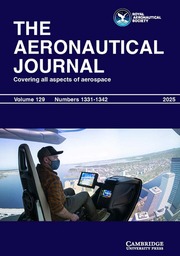No CrossRef data available.
Article contents
A multi-sensor approach for precision UAV landing on dynamic platforms under challenging conditions
Published online by Cambridge University Press: 17 October 2025
Abstract
This study presents the design and evaluation of an autonomous landing system for rotary-wing unmanned aerial vehicles (UAVs) targeting moving platforms. The proposed system leverages the UAV’s onboard positional data and the moving platform’s position, velocity and orientation information to execute high-precision landings. By incorporating the GPS coordinates provided by the mobile platform, the operational envelope of the landing procedure is significantly extended. A Kalman filter is employed to fuse the platform’s GPS data with the UAV’s inertial orientation measurements, enabling accurate estimation of a dynamic rendezvous point along the platform’s trajectory. This facilitates the generation of an optimised landing trajectory that minimises path length and enhances energy efficiency.
A YOLOv8-based object detection model is integrated into the system to detect the landing pad in real time. The effectiveness of the proposed method is validated through scenario-based simulations designed to evaluate landing performance under variable altitudes, crosswind disturbances and limited visibility due to fog.
Across 30 independent runs, the proposed method reduced total autonomous landing time by 12% (191 ± 2.0 s → 168 ± 1.6 s, p < 0.001), halved the landing phase (22.9 ± 0.7 s → 11.1 ± 0.7 s), shortened the path by ≍152 m (2035 ± 6.8 m → 1883 ± 3.1 m), and lowered battery consumption from 5.0 ± 0.1% to 4.0 ± 0.1%. The system maintained successful landings under variable wind (up to 6 m/s) and fog with a 7 m detection range, achieving sub-meter touchdown accuracy (RMSE ≍ 0.15 m); at a 5 m detection limit, landings failed, indicating a robustness boundary.
Compared to existing literature, the developed system introduces a novel 3D trajectory planning approach involving altitude variations and dynamic target prediction. The framework is modular and compatible with various UAV and ground vehicle platforms, making it suitable for diverse mission profiles in both civilian and defense applications.
Keywords
Information
- Type
- Research Article
- Information
- Copyright
- © The Author(s), 2025. Published by Cambridge University Press on behalf of Royal Aeronautical Society


